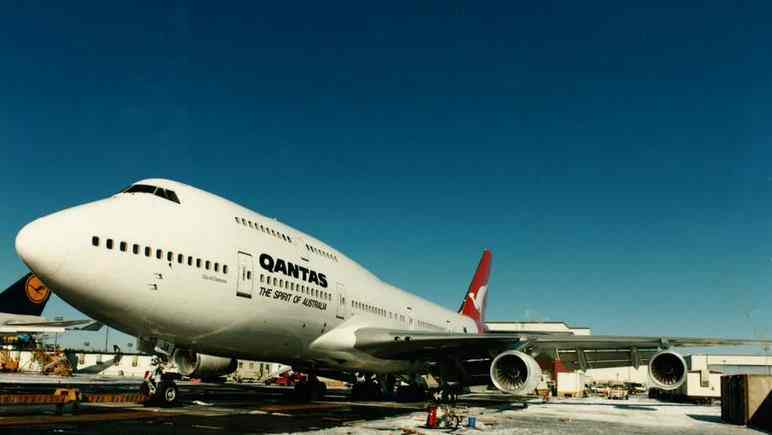Aerospace
Qantas to retire its five oldest Boeing 747 jumbo jets.

As Qantas counts down to the delivery of its first Boeing 787 Dreamliner in October 2017, the clock is also ticking away on the airline’s dwindling fleet of Boeing 747 jumbo jets – once the iconic mainstay of the Qantas international network.
By the middle of 2018, when Qantas expects to have four Dreamliners in its hangars, its two oldest Boeing 747s – one which arrived in 1991, the other in 1998 – will be put out to pasture.
These aircraft are notable for their inclusion of dated first class seats in the jumbo’s nose (shown below), and are most often seen on flights from Sydney to Tokyo, Johannesburg and Santiago.
By mid-2019, with a total of eight Boeing 787s in Qantas stripe, three more red-tailed Boeing 747s will have made their final flight.
These will be largely replaced by the streamlined Boeing 787 or one of Qantas’ six remaining long-range Boeing 747-400ER models which currently fly to Vancouver, San Francisco, Los Angeles and New York.
Farewell to the Queen
Dubbed the Queen of the Skies by its many fans, the Boeing 747 has been overtaken by the larger and more advanced Airbus A380 and the high-tech Boeing 787.
Qantas took delivery of its first Boeing 747 in September 1971, with the jet showcasing a new livery which has since been brought back to life on the Boeing 737 RetroRoo.
More info click : Australian BT

Aerospace
Boeing Transfers Rocket Stage to NASA, Paving Way for Human Moon Mission

Boeing has achieved a significant milestone by providing NASA with the second core stage of the Space Launch System (SLS) rocket.
This crucial component, crafted at NASA’s Michoud Assembly Facility (MAF), is set to propel the Artemis II crew into lunar orbit, marking humanity’s return to deep space after a 50-year hiatus.
The monumental Boeing-built rocket stage, the largest element of the Artemis II mission, will embark on a journey aboard the Pegasus barge, traveling 900 miles to NASA’s Kennedy Space Center.
Comparison of two legendary aircraft B777x vs B747 aircraft:Click here
Upon arrival, it will be meticulously integrated with other essential Artemis II components, including the upper stage, solid rocket boosters, and NASA’s Orion spacecraft within the iconic Vehicle Assembly Building. This intricate integration process is a vital step toward the eagerly anticipated Artemis II launch, slated for 2025.
“Boeing-built products helped land humankind on the moon in 1969, and we’re proud to continue that legacy through the Artemis generation,” remarked Dave Dutcher, vice president and program manager for Boeing’s SLS program. “Together, with NASA and our industry partners and suppliers, we are building the world’s most capable rocket and paving the way to deep space through America’s rocket factory in New Orleans.”
NASA, Lockheed Martin Reveal X-59 Quiet Supersonic Aircraft:Click here
The delivery of Core Stage 2 marks a significant achievement in the evolution of the SLS rocket. Towering over 200 feet and powered by four RS-25 engines, this core stage, coupled with two solid-fueled booster rockets, will generate a staggering 8.8 million pounds of thrust. This immense power is crucial to launching Artemis II and future missions into the vast expanse of space.
The SLS rocket stands unparalleled in its capability to transport both crew and substantial cargo to the moon and beyond in a single launch. Its extraordinary capacity will facilitate the delivery of human-rated spacecraft, habitats, and scientific missions to destinations including the moon and Mars, ushering in a new era of space exploration.
-

 Travel1 week ago
Travel1 week agoAir India to Expand US Operations with Three New Routes After a Decade
-

 Travel2 weeks ago
Travel2 weeks agoWhy We Should Avoid These Stamps in a Passport
-

 Airlines1 month ago
Airlines1 month agoInvestigations Reveal Fake Chinese Titanium in Boeing and Airbus Jets
-

 Tech4 weeks ago
Tech4 weeks agoChina’s CATL Plans 1,800-Mile Electric Plane Launch by 2027
-

 Airport3 days ago
Airport3 days agoTop 10 Largest Airports in the World by Size
-

 Aerospace4 weeks ago
Aerospace4 weeks agoChina’s Fighter Jets Turn Wings into Autonomous Drones
-

 Airlines4 days ago
Airlines4 days agoAir India Rolls Out A350s for Delhi-New York JFK and Newark Routes
-

 Defence3 weeks ago
Defence3 weeks agoBoeing Enhances Chinook with New Engines and Block II Upgrades at $96 Million







